Australian Retailing Industry Assignment
VerifiedAdded on 2022/09/17
|12
|2941
|25
AI Summary
Contribute Materials
Your contribution can guide someone’s learning journey. Share your
documents today.
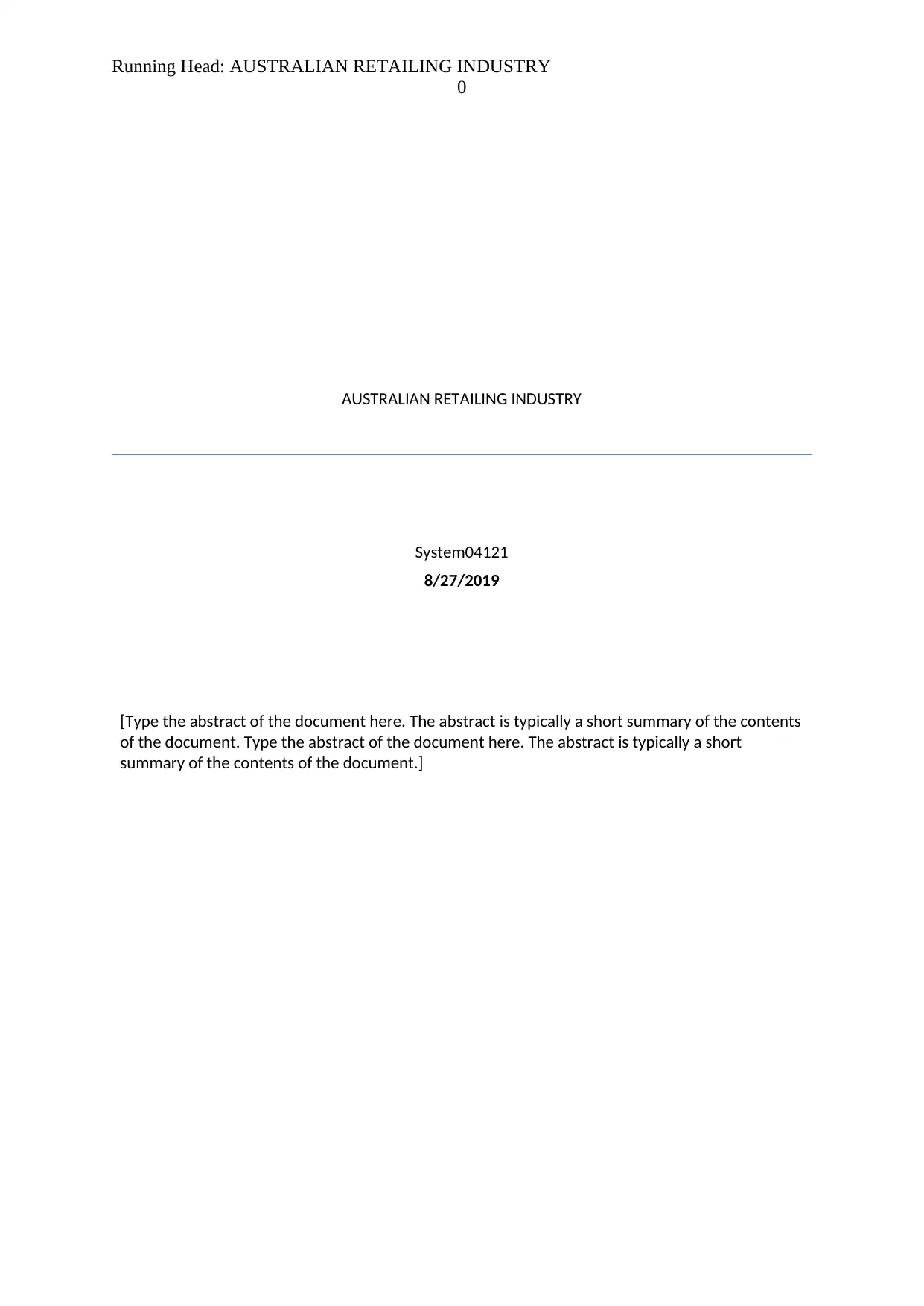
Running Head: AUSTRALIAN RETAILING INDUSTRY
0
AUSTRALIAN RETAILING INDUSTRY
System04121
8/27/2019
[Type the abstract of the document here. The abstract is typically a short summary of the contents
of the document. Type the abstract of the document here. The abstract is typically a short
summary of the contents of the document.]
0
AUSTRALIAN RETAILING INDUSTRY
System04121
8/27/2019
[Type the abstract of the document here. The abstract is typically a short summary of the contents
of the document. Type the abstract of the document here. The abstract is typically a short
summary of the contents of the document.]
Secure Best Marks with AI Grader
Need help grading? Try our AI Grader for instant feedback on your assignments.
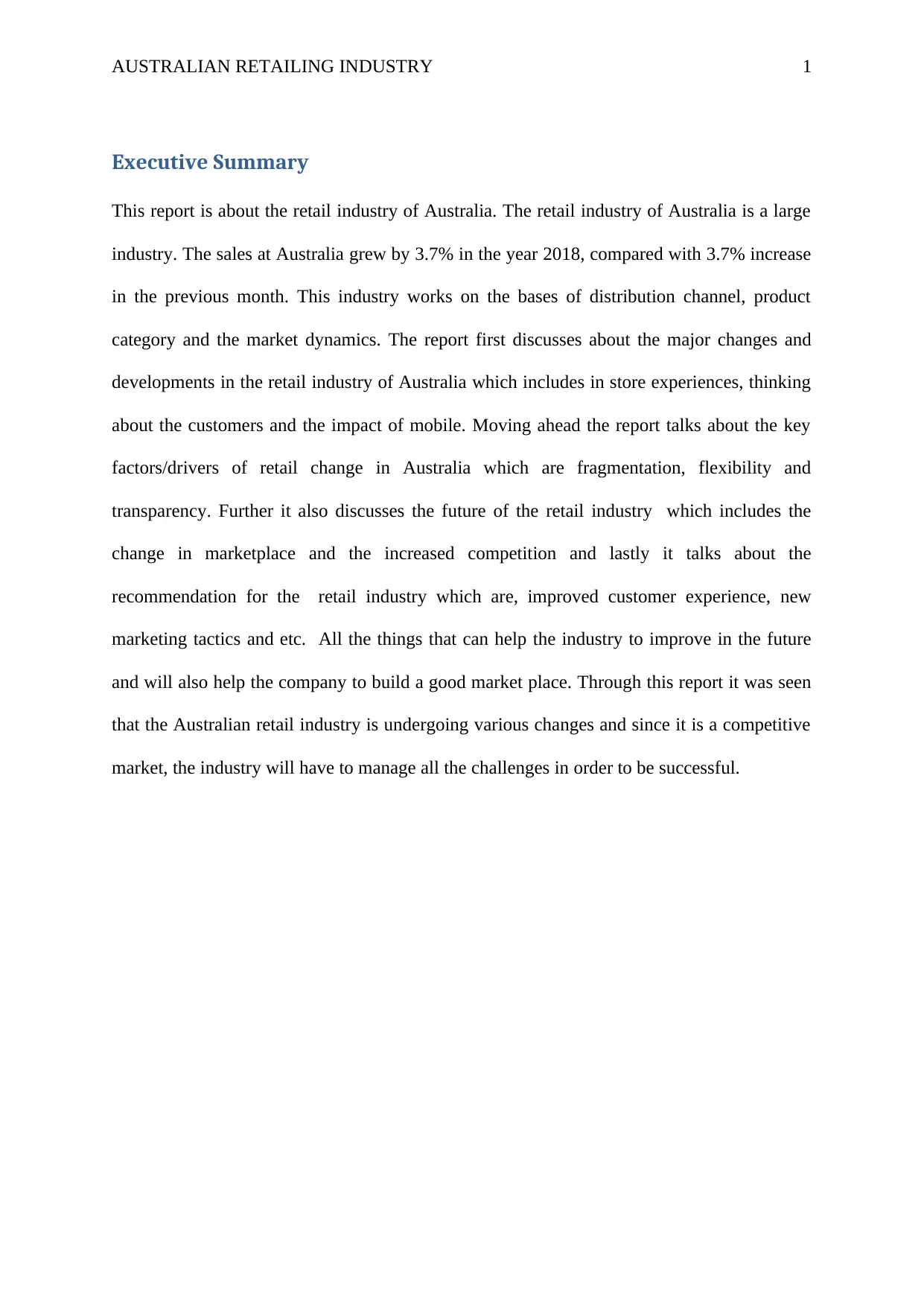
AUSTRALIAN RETAILING INDUSTRY 1
Executive Summary
This report is about the retail industry of Australia. The retail industry of Australia is a large
industry. The sales at Australia grew by 3.7% in the year 2018, compared with 3.7% increase
in the previous month. This industry works on the bases of distribution channel, product
category and the market dynamics. The report first discusses about the major changes and
developments in the retail industry of Australia which includes in store experiences, thinking
about the customers and the impact of mobile. Moving ahead the report talks about the key
factors/drivers of retail change in Australia which are fragmentation, flexibility and
transparency. Further it also discusses the future of the retail industry which includes the
change in marketplace and the increased competition and lastly it talks about the
recommendation for the retail industry which are, improved customer experience, new
marketing tactics and etc. All the things that can help the industry to improve in the future
and will also help the company to build a good market place. Through this report it was seen
that the Australian retail industry is undergoing various changes and since it is a competitive
market, the industry will have to manage all the challenges in order to be successful.
Executive Summary
This report is about the retail industry of Australia. The retail industry of Australia is a large
industry. The sales at Australia grew by 3.7% in the year 2018, compared with 3.7% increase
in the previous month. This industry works on the bases of distribution channel, product
category and the market dynamics. The report first discusses about the major changes and
developments in the retail industry of Australia which includes in store experiences, thinking
about the customers and the impact of mobile. Moving ahead the report talks about the key
factors/drivers of retail change in Australia which are fragmentation, flexibility and
transparency. Further it also discusses the future of the retail industry which includes the
change in marketplace and the increased competition and lastly it talks about the
recommendation for the retail industry which are, improved customer experience, new
marketing tactics and etc. All the things that can help the industry to improve in the future
and will also help the company to build a good market place. Through this report it was seen
that the Australian retail industry is undergoing various changes and since it is a competitive
market, the industry will have to manage all the challenges in order to be successful.
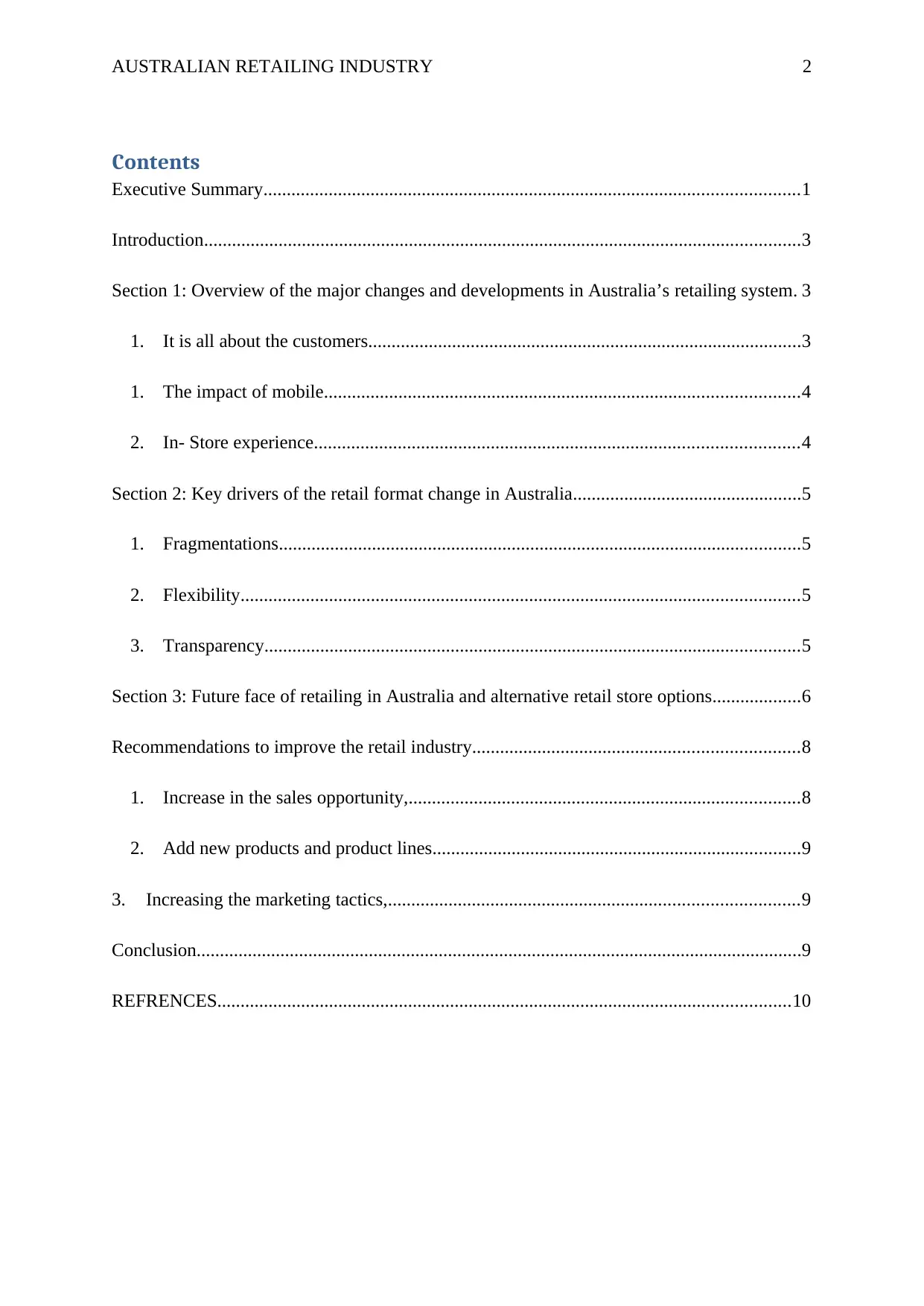
AUSTRALIAN RETAILING INDUSTRY 2
Contents
Executive Summary...................................................................................................................1
Introduction................................................................................................................................3
Section 1: Overview of the major changes and developments in Australia’s retailing system. 3
1. It is all about the customers.............................................................................................3
1. The impact of mobile......................................................................................................4
2. In- Store experience........................................................................................................4
Section 2: Key drivers of the retail format change in Australia.................................................5
1. Fragmentations................................................................................................................5
2. Flexibility........................................................................................................................5
3. Transparency...................................................................................................................5
Section 3: Future face of retailing in Australia and alternative retail store options...................6
Recommendations to improve the retail industry......................................................................8
1. Increase in the sales opportunity,....................................................................................8
2. Add new products and product lines...............................................................................9
3. Increasing the marketing tactics,........................................................................................9
Conclusion..................................................................................................................................9
REFRENCES...........................................................................................................................10
Contents
Executive Summary...................................................................................................................1
Introduction................................................................................................................................3
Section 1: Overview of the major changes and developments in Australia’s retailing system. 3
1. It is all about the customers.............................................................................................3
1. The impact of mobile......................................................................................................4
2. In- Store experience........................................................................................................4
Section 2: Key drivers of the retail format change in Australia.................................................5
1. Fragmentations................................................................................................................5
2. Flexibility........................................................................................................................5
3. Transparency...................................................................................................................5
Section 3: Future face of retailing in Australia and alternative retail store options...................6
Recommendations to improve the retail industry......................................................................8
1. Increase in the sales opportunity,....................................................................................8
2. Add new products and product lines...............................................................................9
3. Increasing the marketing tactics,........................................................................................9
Conclusion..................................................................................................................................9
REFRENCES...........................................................................................................................10

AUSTRALIAN RETAILING INDUSTRY 3
Secure Best Marks with AI Grader
Need help grading? Try our AI Grader for instant feedback on your assignments.
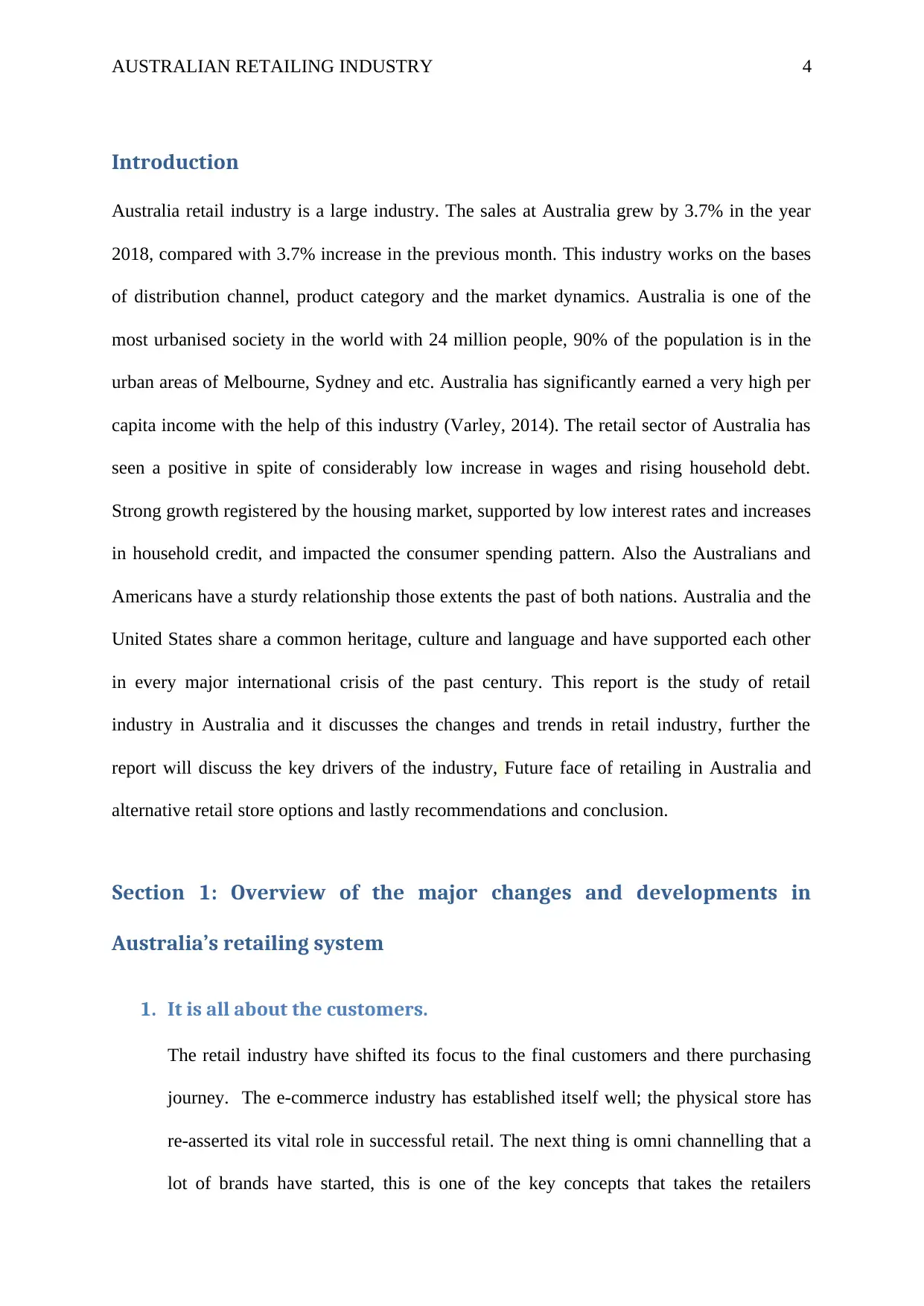
AUSTRALIAN RETAILING INDUSTRY 4
Introduction
Australia retail industry is a large industry. The sales at Australia grew by 3.7% in the year
2018, compared with 3.7% increase in the previous month. This industry works on the bases
of distribution channel, product category and the market dynamics. Australia is one of the
most urbanised society in the world with 24 million people, 90% of the population is in the
urban areas of Melbourne, Sydney and etc. Australia has significantly earned a very high per
capita income with the help of this industry (Varley, 2014). The retail sector of Australia has
seen a positive in spite of considerably low increase in wages and rising household debt.
Strong growth registered by the housing market, supported by low interest rates and increases
in household credit, and impacted the consumer spending pattern. Also the Australians and
Americans have a sturdy relationship those extents the past of both nations. Australia and the
United States share a common heritage, culture and language and have supported each other
in every major international crisis of the past century. This report is the study of retail
industry in Australia and it discusses the changes and trends in retail industry, further the
report will discuss the key drivers of the industry, Future face of retailing in Australia and
alternative retail store options and lastly recommendations and conclusion.
Section 1: Overview of the major changes and developments in
Australia’s retailing system
1. It is all about the customers.
The retail industry have shifted its focus to the final customers and there purchasing
journey. The e-commerce industry has established itself well; the physical store has
re-asserted its vital role in successful retail. The next thing is omni channelling that a
lot of brands have started, this is one of the key concepts that takes the retailers
Introduction
Australia retail industry is a large industry. The sales at Australia grew by 3.7% in the year
2018, compared with 3.7% increase in the previous month. This industry works on the bases
of distribution channel, product category and the market dynamics. Australia is one of the
most urbanised society in the world with 24 million people, 90% of the population is in the
urban areas of Melbourne, Sydney and etc. Australia has significantly earned a very high per
capita income with the help of this industry (Varley, 2014). The retail sector of Australia has
seen a positive in spite of considerably low increase in wages and rising household debt.
Strong growth registered by the housing market, supported by low interest rates and increases
in household credit, and impacted the consumer spending pattern. Also the Australians and
Americans have a sturdy relationship those extents the past of both nations. Australia and the
United States share a common heritage, culture and language and have supported each other
in every major international crisis of the past century. This report is the study of retail
industry in Australia and it discusses the changes and trends in retail industry, further the
report will discuss the key drivers of the industry, Future face of retailing in Australia and
alternative retail store options and lastly recommendations and conclusion.
Section 1: Overview of the major changes and developments in
Australia’s retailing system
1. It is all about the customers.
The retail industry have shifted its focus to the final customers and there purchasing
journey. The e-commerce industry has established itself well; the physical store has
re-asserted its vital role in successful retail. The next thing is omni channelling that a
lot of brands have started, this is one of the key concepts that takes the retailers
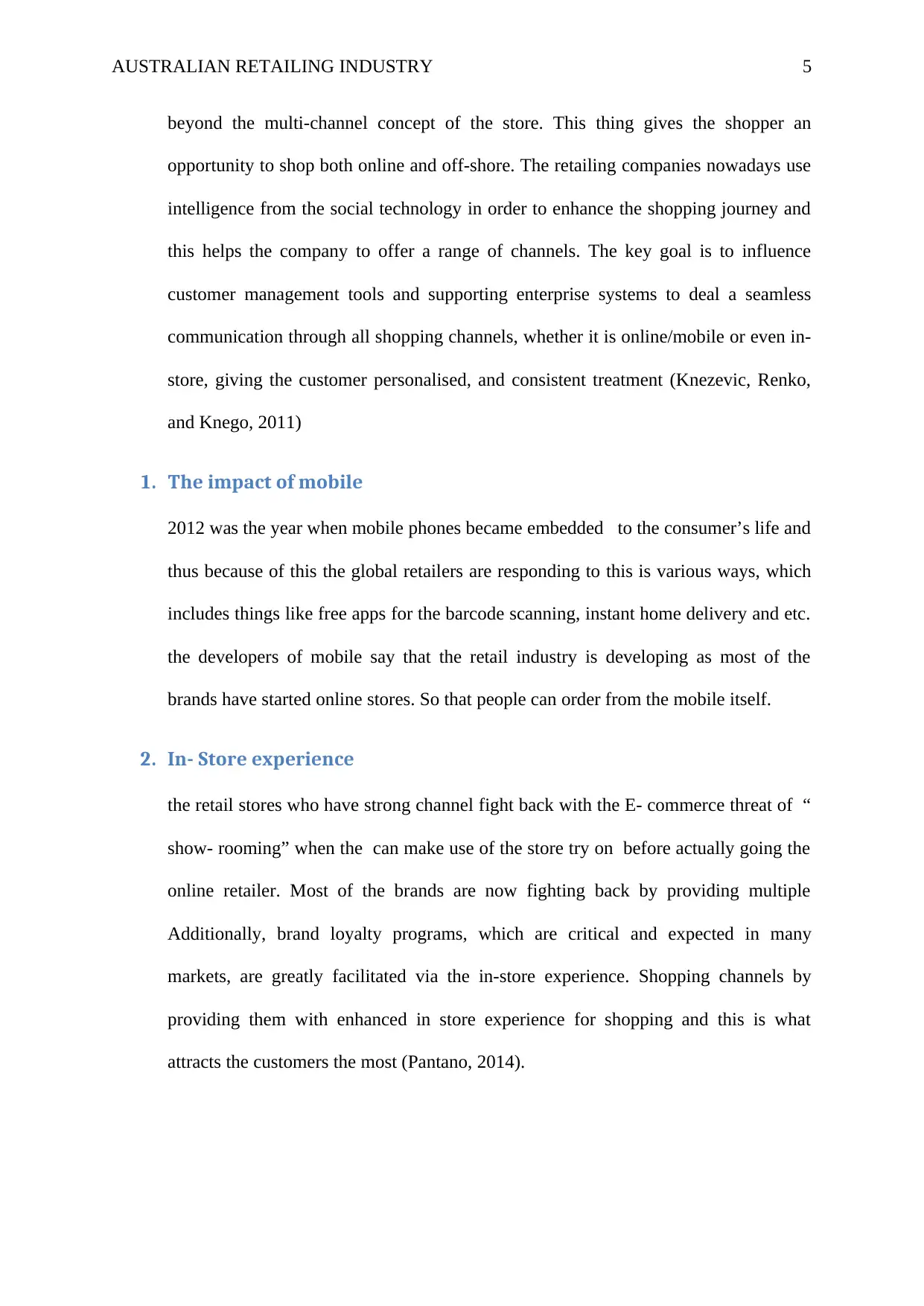
AUSTRALIAN RETAILING INDUSTRY 5
beyond the multi-channel concept of the store. This thing gives the shopper an
opportunity to shop both online and off-shore. The retailing companies nowadays use
intelligence from the social technology in order to enhance the shopping journey and
this helps the company to offer a range of channels. The key goal is to influence
customer management tools and supporting enterprise systems to deal a seamless
communication through all shopping channels, whether it is online/mobile or even in-
store, giving the customer personalised, and consistent treatment (Knezevic, Renko,
and Knego, 2011)
1. The impact of mobile
2012 was the year when mobile phones became embedded to the consumer’s life and
thus because of this the global retailers are responding to this is various ways, which
includes things like free apps for the barcode scanning, instant home delivery and etc.
the developers of mobile say that the retail industry is developing as most of the
brands have started online stores. So that people can order from the mobile itself.
2. In- Store experience
the retail stores who have strong channel fight back with the E- commerce threat of “
show- rooming” when the can make use of the store try on before actually going the
online retailer. Most of the brands are now fighting back by providing multiple
Additionally, brand loyalty programs, which are critical and expected in many
markets, are greatly facilitated via the in-store experience. Shopping channels by
providing them with enhanced in store experience for shopping and this is what
attracts the customers the most (Pantano, 2014).
beyond the multi-channel concept of the store. This thing gives the shopper an
opportunity to shop both online and off-shore. The retailing companies nowadays use
intelligence from the social technology in order to enhance the shopping journey and
this helps the company to offer a range of channels. The key goal is to influence
customer management tools and supporting enterprise systems to deal a seamless
communication through all shopping channels, whether it is online/mobile or even in-
store, giving the customer personalised, and consistent treatment (Knezevic, Renko,
and Knego, 2011)
1. The impact of mobile
2012 was the year when mobile phones became embedded to the consumer’s life and
thus because of this the global retailers are responding to this is various ways, which
includes things like free apps for the barcode scanning, instant home delivery and etc.
the developers of mobile say that the retail industry is developing as most of the
brands have started online stores. So that people can order from the mobile itself.
2. In- Store experience
the retail stores who have strong channel fight back with the E- commerce threat of “
show- rooming” when the can make use of the store try on before actually going the
online retailer. Most of the brands are now fighting back by providing multiple
Additionally, brand loyalty programs, which are critical and expected in many
markets, are greatly facilitated via the in-store experience. Shopping channels by
providing them with enhanced in store experience for shopping and this is what
attracts the customers the most (Pantano, 2014).
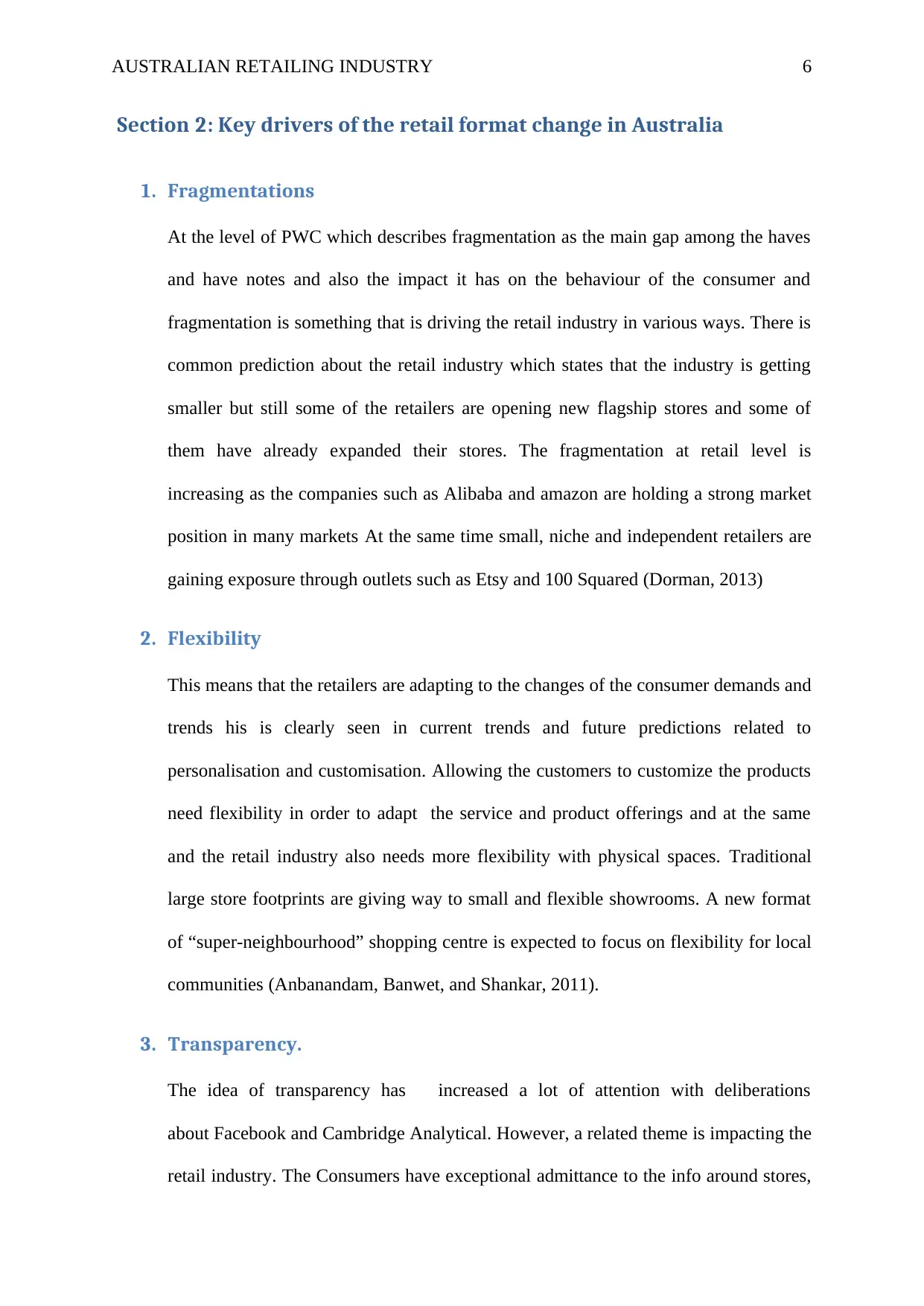
AUSTRALIAN RETAILING INDUSTRY 6
Section 2: Key drivers of the retail format change in Australia
1. Fragmentations
At the level of PWC which describes fragmentation as the main gap among the haves
and have notes and also the impact it has on the behaviour of the consumer and
fragmentation is something that is driving the retail industry in various ways. There is
common prediction about the retail industry which states that the industry is getting
smaller but still some of the retailers are opening new flagship stores and some of
them have already expanded their stores. The fragmentation at retail level is
increasing as the companies such as Alibaba and amazon are holding a strong market
position in many markets At the same time small, niche and independent retailers are
gaining exposure through outlets such as Etsy and 100 Squared (Dorman, 2013)
2. Flexibility
This means that the retailers are adapting to the changes of the consumer demands and
trends his is clearly seen in current trends and future predictions related to
personalisation and customisation. Allowing the customers to customize the products
need flexibility in order to adapt the service and product offerings and at the same
and the retail industry also needs more flexibility with physical spaces. Traditional
large store footprints are giving way to small and flexible showrooms. A new format
of “super-neighbourhood” shopping centre is expected to focus on flexibility for local
communities (Anbanandam, Banwet, and Shankar, 2011).
3. Transparency.
The idea of transparency has increased a lot of attention with deliberations
about Facebook and Cambridge Analytical. However, a related theme is impacting the
retail industry. The Consumers have exceptional admittance to the info around stores,
Section 2: Key drivers of the retail format change in Australia
1. Fragmentations
At the level of PWC which describes fragmentation as the main gap among the haves
and have notes and also the impact it has on the behaviour of the consumer and
fragmentation is something that is driving the retail industry in various ways. There is
common prediction about the retail industry which states that the industry is getting
smaller but still some of the retailers are opening new flagship stores and some of
them have already expanded their stores. The fragmentation at retail level is
increasing as the companies such as Alibaba and amazon are holding a strong market
position in many markets At the same time small, niche and independent retailers are
gaining exposure through outlets such as Etsy and 100 Squared (Dorman, 2013)
2. Flexibility
This means that the retailers are adapting to the changes of the consumer demands and
trends his is clearly seen in current trends and future predictions related to
personalisation and customisation. Allowing the customers to customize the products
need flexibility in order to adapt the service and product offerings and at the same
and the retail industry also needs more flexibility with physical spaces. Traditional
large store footprints are giving way to small and flexible showrooms. A new format
of “super-neighbourhood” shopping centre is expected to focus on flexibility for local
communities (Anbanandam, Banwet, and Shankar, 2011).
3. Transparency.
The idea of transparency has increased a lot of attention with deliberations
about Facebook and Cambridge Analytical. However, a related theme is impacting the
retail industry. The Consumers have exceptional admittance to the info around stores,
Paraphrase This Document
Need a fresh take? Get an instant paraphrase of this document with our AI Paraphraser
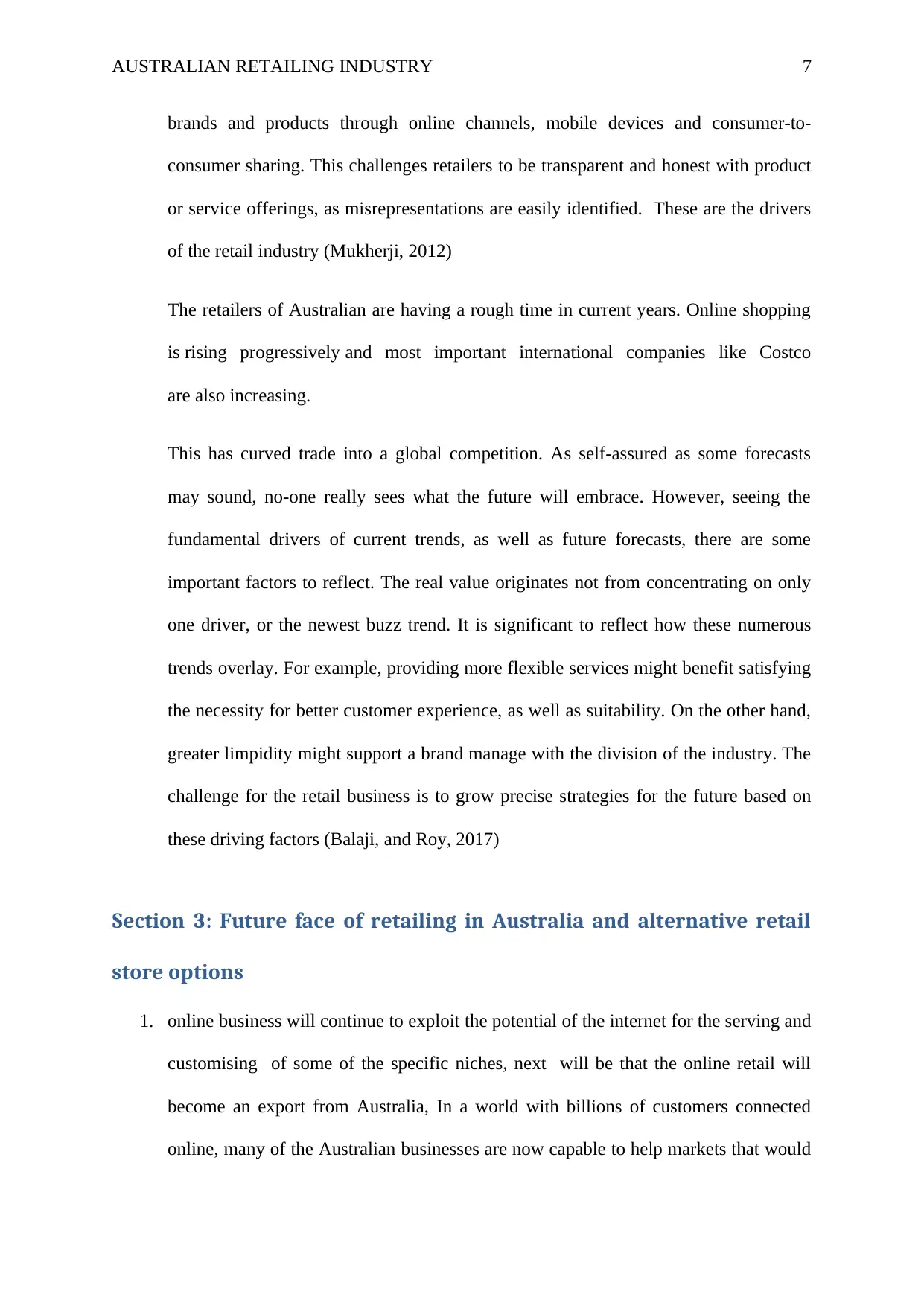
AUSTRALIAN RETAILING INDUSTRY 7
brands and products through online channels, mobile devices and consumer-to-
consumer sharing. This challenges retailers to be transparent and honest with product
or service offerings, as misrepresentations are easily identified. These are the drivers
of the retail industry (Mukherji, 2012)
The retailers of Australian are having a rough time in current years. Online shopping
is rising progressively and most important international companies like Costco
are also increasing.
This has curved trade into a global competition. As self-assured as some forecasts
may sound, no-one really sees what the future will embrace. However, seeing the
fundamental drivers of current trends, as well as future forecasts, there are some
important factors to reflect. The real value originates not from concentrating on only
one driver, or the newest buzz trend. It is significant to reflect how these numerous
trends overlay. For example, providing more flexible services might benefit satisfying
the necessity for better customer experience, as well as suitability. On the other hand,
greater limpidity might support a brand manage with the division of the industry. The
challenge for the retail business is to grow precise strategies for the future based on
these driving factors (Balaji, and Roy, 2017)
Section 3: Future face of retailing in Australia and alternative retail
store options
1. online business will continue to exploit the potential of the internet for the serving and
customising of some of the specific niches, next will be that the online retail will
become an export from Australia, In a world with billions of customers connected
online, many of the Australian businesses are now capable to help markets that would
brands and products through online channels, mobile devices and consumer-to-
consumer sharing. This challenges retailers to be transparent and honest with product
or service offerings, as misrepresentations are easily identified. These are the drivers
of the retail industry (Mukherji, 2012)
The retailers of Australian are having a rough time in current years. Online shopping
is rising progressively and most important international companies like Costco
are also increasing.
This has curved trade into a global competition. As self-assured as some forecasts
may sound, no-one really sees what the future will embrace. However, seeing the
fundamental drivers of current trends, as well as future forecasts, there are some
important factors to reflect. The real value originates not from concentrating on only
one driver, or the newest buzz trend. It is significant to reflect how these numerous
trends overlay. For example, providing more flexible services might benefit satisfying
the necessity for better customer experience, as well as suitability. On the other hand,
greater limpidity might support a brand manage with the division of the industry. The
challenge for the retail business is to grow precise strategies for the future based on
these driving factors (Balaji, and Roy, 2017)
Section 3: Future face of retailing in Australia and alternative retail
store options
1. online business will continue to exploit the potential of the internet for the serving and
customising of some of the specific niches, next will be that the online retail will
become an export from Australia, In a world with billions of customers connected
online, many of the Australian businesses are now capable to help markets that would
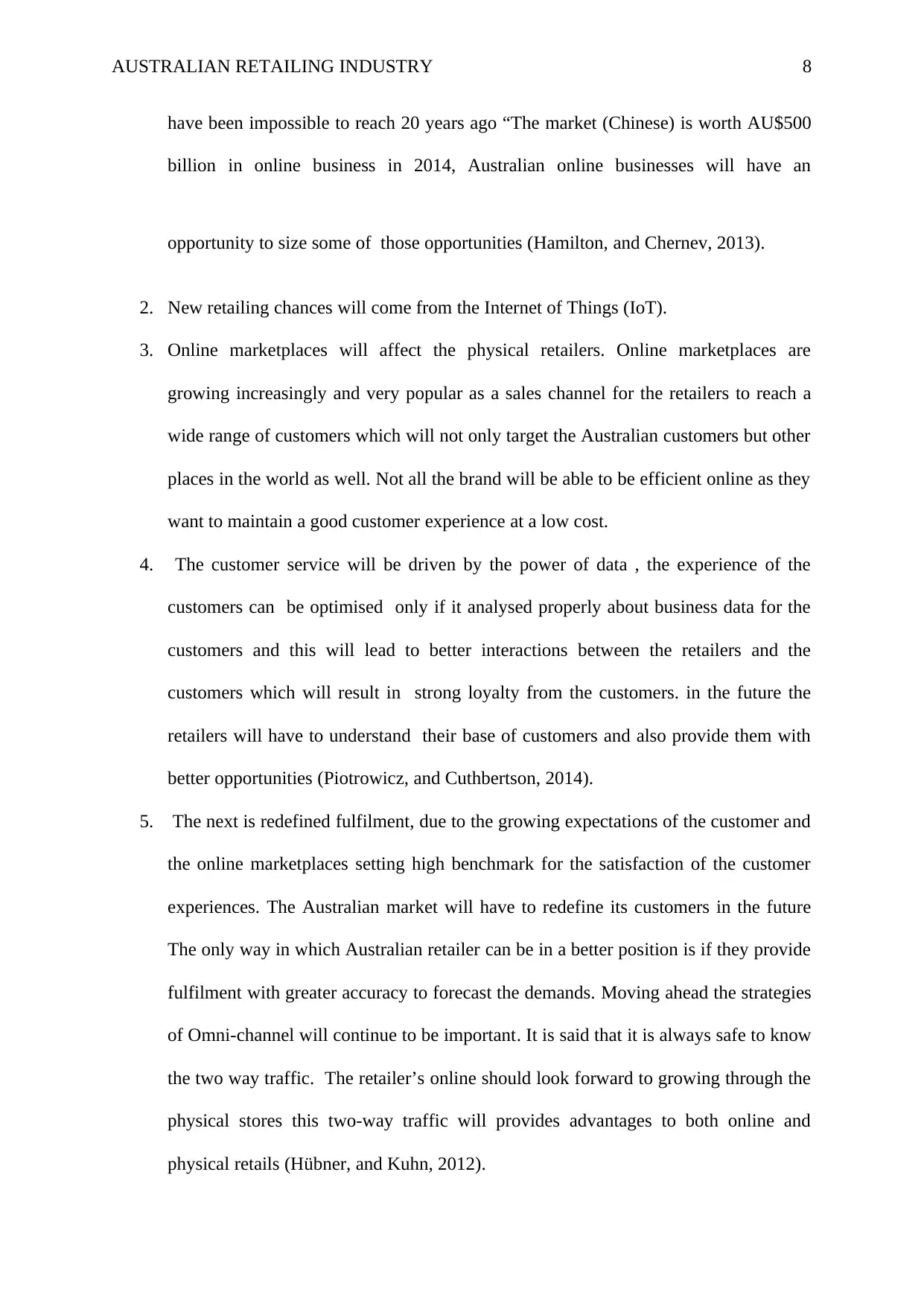
AUSTRALIAN RETAILING INDUSTRY 8
have been impossible to reach 20 years ago “The market (Chinese) is worth AU$500
billion in online business in 2014, Australian online businesses will have an
opportunity to size some of those opportunities (Hamilton, and Chernev, 2013).
2. New retailing chances will come from the Internet of Things (IoT).
3. Online marketplaces will affect the physical retailers. Online marketplaces are
growing increasingly and very popular as a sales channel for the retailers to reach a
wide range of customers which will not only target the Australian customers but other
places in the world as well. Not all the brand will be able to be efficient online as they
want to maintain a good customer experience at a low cost.
4. The customer service will be driven by the power of data , the experience of the
customers can be optimised only if it analysed properly about business data for the
customers and this will lead to better interactions between the retailers and the
customers which will result in strong loyalty from the customers. in the future the
retailers will have to understand their base of customers and also provide them with
better opportunities (Piotrowicz, and Cuthbertson, 2014).
5. The next is redefined fulfilment, due to the growing expectations of the customer and
the online marketplaces setting high benchmark for the satisfaction of the customer
experiences. The Australian market will have to redefine its customers in the future
The only way in which Australian retailer can be in a better position is if they provide
fulfilment with greater accuracy to forecast the demands. Moving ahead the strategies
of Omni-channel will continue to be important. It is said that it is always safe to know
the two way traffic. The retailer’s online should look forward to growing through the
physical stores this two-way traffic will provides advantages to both online and
physical retails (Hübner, and Kuhn, 2012).
have been impossible to reach 20 years ago “The market (Chinese) is worth AU$500
billion in online business in 2014, Australian online businesses will have an
opportunity to size some of those opportunities (Hamilton, and Chernev, 2013).
2. New retailing chances will come from the Internet of Things (IoT).
3. Online marketplaces will affect the physical retailers. Online marketplaces are
growing increasingly and very popular as a sales channel for the retailers to reach a
wide range of customers which will not only target the Australian customers but other
places in the world as well. Not all the brand will be able to be efficient online as they
want to maintain a good customer experience at a low cost.
4. The customer service will be driven by the power of data , the experience of the
customers can be optimised only if it analysed properly about business data for the
customers and this will lead to better interactions between the retailers and the
customers which will result in strong loyalty from the customers. in the future the
retailers will have to understand their base of customers and also provide them with
better opportunities (Piotrowicz, and Cuthbertson, 2014).
5. The next is redefined fulfilment, due to the growing expectations of the customer and
the online marketplaces setting high benchmark for the satisfaction of the customer
experiences. The Australian market will have to redefine its customers in the future
The only way in which Australian retailer can be in a better position is if they provide
fulfilment with greater accuracy to forecast the demands. Moving ahead the strategies
of Omni-channel will continue to be important. It is said that it is always safe to know
the two way traffic. The retailer’s online should look forward to growing through the
physical stores this two-way traffic will provides advantages to both online and
physical retails (Hübner, and Kuhn, 2012).
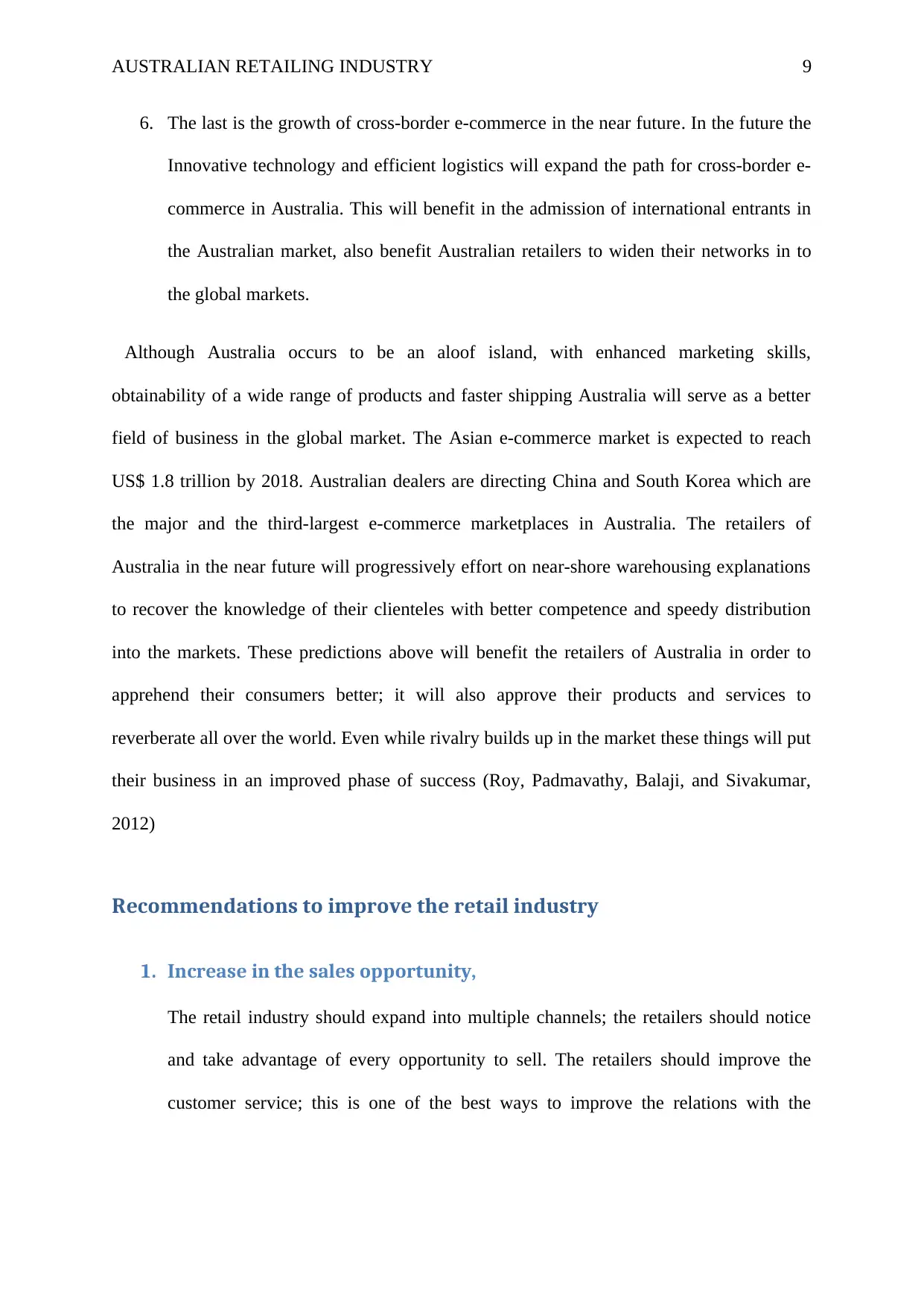
AUSTRALIAN RETAILING INDUSTRY 9
6. The last is the growth of cross-border e-commerce in the near future. In the future the
Innovative technology and efficient logistics will expand the path for cross-border e-
commerce in Australia. This will benefit in the admission of international entrants in
the Australian market, also benefit Australian retailers to widen their networks in to
the global markets.
Although Australia occurs to be an aloof island, with enhanced marketing skills,
obtainability of a wide range of products and faster shipping Australia will serve as a better
field of business in the global market. The Asian e-commerce market is expected to reach
US$ 1.8 trillion by 2018. Australian dealers are directing China and South Korea which are
the major and the third-largest e-commerce marketplaces in Australia. The retailers of
Australia in the near future will progressively effort on near-shore warehousing explanations
to recover the knowledge of their clienteles with better competence and speedy distribution
into the markets. These predictions above will benefit the retailers of Australia in order to
apprehend their consumers better; it will also approve their products and services to
reverberate all over the world. Even while rivalry builds up in the market these things will put
their business in an improved phase of success (Roy, Padmavathy, Balaji, and Sivakumar,
2012)
Recommendations to improve the retail industry
1. Increase in the sales opportunity,
The retail industry should expand into multiple channels; the retailers should notice
and take advantage of every opportunity to sell. The retailers should improve the
customer service; this is one of the best ways to improve the relations with the
6. The last is the growth of cross-border e-commerce in the near future. In the future the
Innovative technology and efficient logistics will expand the path for cross-border e-
commerce in Australia. This will benefit in the admission of international entrants in
the Australian market, also benefit Australian retailers to widen their networks in to
the global markets.
Although Australia occurs to be an aloof island, with enhanced marketing skills,
obtainability of a wide range of products and faster shipping Australia will serve as a better
field of business in the global market. The Asian e-commerce market is expected to reach
US$ 1.8 trillion by 2018. Australian dealers are directing China and South Korea which are
the major and the third-largest e-commerce marketplaces in Australia. The retailers of
Australia in the near future will progressively effort on near-shore warehousing explanations
to recover the knowledge of their clienteles with better competence and speedy distribution
into the markets. These predictions above will benefit the retailers of Australia in order to
apprehend their consumers better; it will also approve their products and services to
reverberate all over the world. Even while rivalry builds up in the market these things will put
their business in an improved phase of success (Roy, Padmavathy, Balaji, and Sivakumar,
2012)
Recommendations to improve the retail industry
1. Increase in the sales opportunity,
The retail industry should expand into multiple channels; the retailers should notice
and take advantage of every opportunity to sell. The retailers should improve the
customer service; this is one of the best ways to improve the relations with the
Secure Best Marks with AI Grader
Need help grading? Try our AI Grader for instant feedback on your assignments.
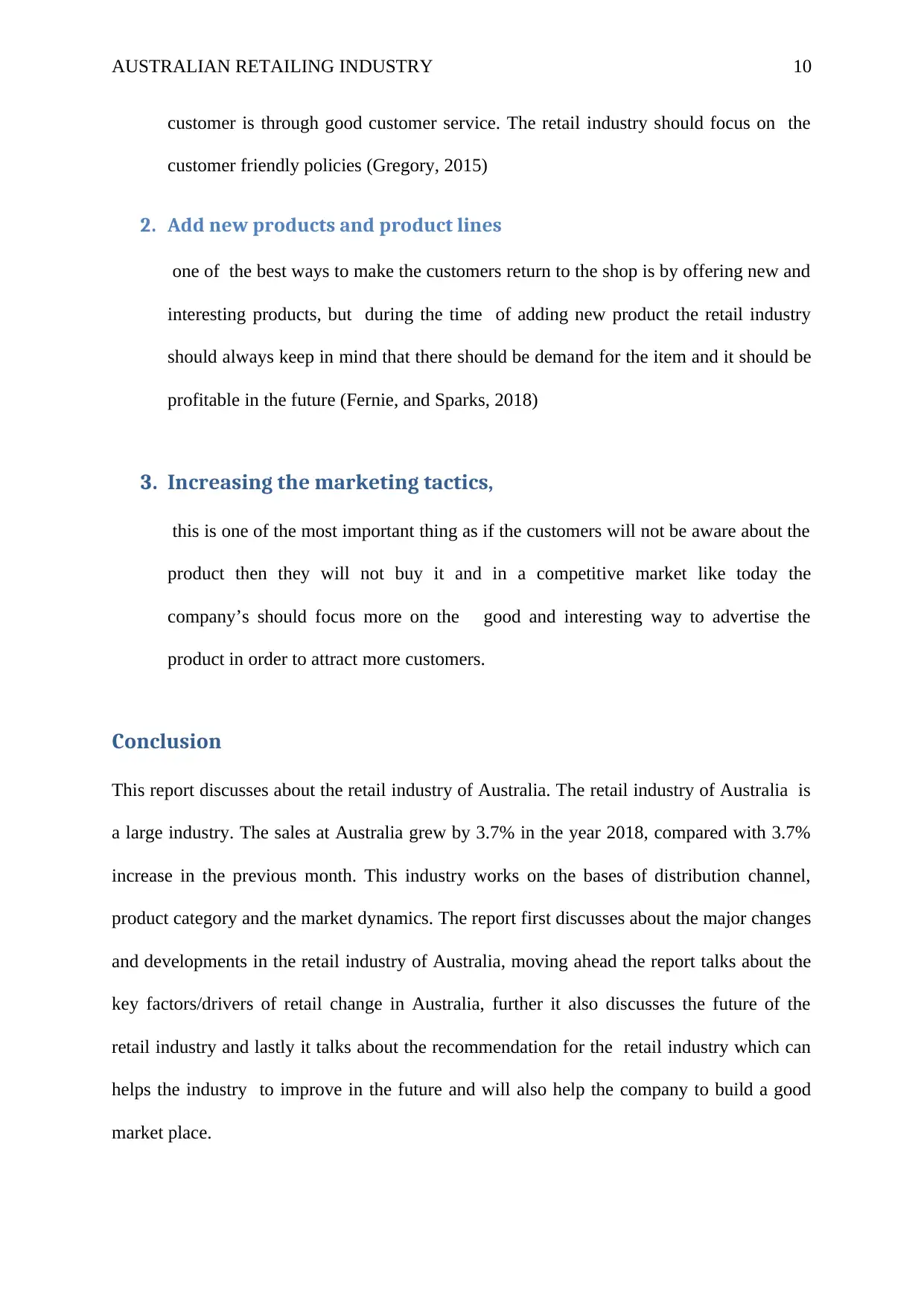
AUSTRALIAN RETAILING INDUSTRY 10
customer is through good customer service. The retail industry should focus on the
customer friendly policies (Gregory, 2015)
2. Add new products and product lines
one of the best ways to make the customers return to the shop is by offering new and
interesting products, but during the time of adding new product the retail industry
should always keep in mind that there should be demand for the item and it should be
profitable in the future (Fernie, and Sparks, 2018)
3. Increasing the marketing tactics,
this is one of the most important thing as if the customers will not be aware about the
product then they will not buy it and in a competitive market like today the
company’s should focus more on the good and interesting way to advertise the
product in order to attract more customers.
Conclusion
This report discusses about the retail industry of Australia. The retail industry of Australia is
a large industry. The sales at Australia grew by 3.7% in the year 2018, compared with 3.7%
increase in the previous month. This industry works on the bases of distribution channel,
product category and the market dynamics. The report first discusses about the major changes
and developments in the retail industry of Australia, moving ahead the report talks about the
key factors/drivers of retail change in Australia, further it also discusses the future of the
retail industry and lastly it talks about the recommendation for the retail industry which can
helps the industry to improve in the future and will also help the company to build a good
market place.
customer is through good customer service. The retail industry should focus on the
customer friendly policies (Gregory, 2015)
2. Add new products and product lines
one of the best ways to make the customers return to the shop is by offering new and
interesting products, but during the time of adding new product the retail industry
should always keep in mind that there should be demand for the item and it should be
profitable in the future (Fernie, and Sparks, 2018)
3. Increasing the marketing tactics,
this is one of the most important thing as if the customers will not be aware about the
product then they will not buy it and in a competitive market like today the
company’s should focus more on the good and interesting way to advertise the
product in order to attract more customers.
Conclusion
This report discusses about the retail industry of Australia. The retail industry of Australia is
a large industry. The sales at Australia grew by 3.7% in the year 2018, compared with 3.7%
increase in the previous month. This industry works on the bases of distribution channel,
product category and the market dynamics. The report first discusses about the major changes
and developments in the retail industry of Australia, moving ahead the report talks about the
key factors/drivers of retail change in Australia, further it also discusses the future of the
retail industry and lastly it talks about the recommendation for the retail industry which can
helps the industry to improve in the future and will also help the company to build a good
market place.
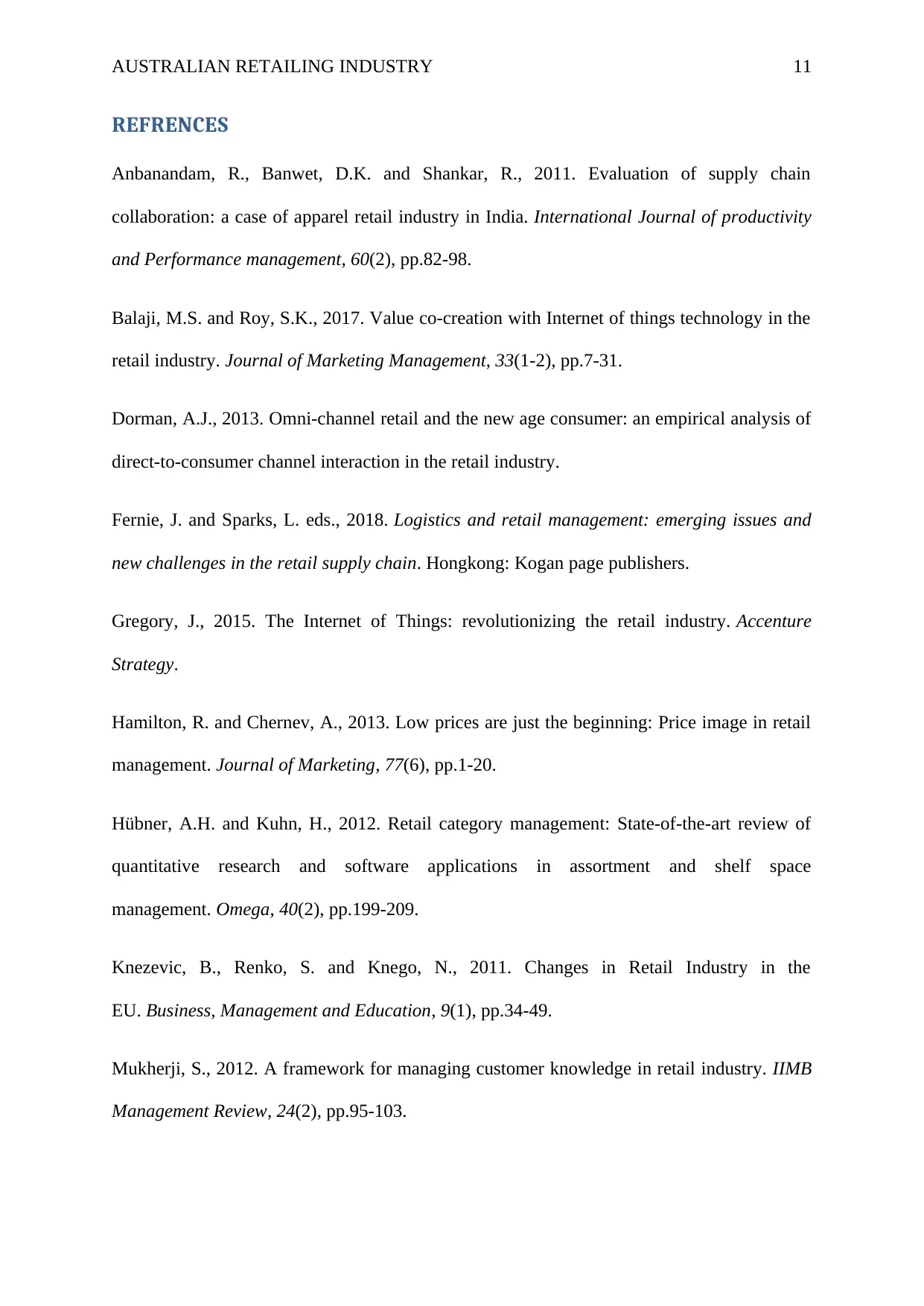
AUSTRALIAN RETAILING INDUSTRY 11
REFRENCES
Anbanandam, R., Banwet, D.K. and Shankar, R., 2011. Evaluation of supply chain
collaboration: a case of apparel retail industry in India. International Journal of productivity
and Performance management, 60(2), pp.82-98.
Balaji, M.S. and Roy, S.K., 2017. Value co-creation with Internet of things technology in the
retail industry. Journal of Marketing Management, 33(1-2), pp.7-31.
Dorman, A.J., 2013. Omni-channel retail and the new age consumer: an empirical analysis of
direct-to-consumer channel interaction in the retail industry.
Fernie, J. and Sparks, L. eds., 2018. Logistics and retail management: emerging issues and
new challenges in the retail supply chain. Hongkong: Kogan page publishers.
Gregory, J., 2015. The Internet of Things: revolutionizing the retail industry. Accenture
Strategy.
Hamilton, R. and Chernev, A., 2013. Low prices are just the beginning: Price image in retail
management. Journal of Marketing, 77(6), pp.1-20.
Hübner, A.H. and Kuhn, H., 2012. Retail category management: State-of-the-art review of
quantitative research and software applications in assortment and shelf space
management. Omega, 40(2), pp.199-209.
Knezevic, B., Renko, S. and Knego, N., 2011. Changes in Retail Industry in the
EU. Business, Management and Education, 9(1), pp.34-49.
Mukherji, S., 2012. A framework for managing customer knowledge in retail industry. IIMB
Management Review, 24(2), pp.95-103.
REFRENCES
Anbanandam, R., Banwet, D.K. and Shankar, R., 2011. Evaluation of supply chain
collaboration: a case of apparel retail industry in India. International Journal of productivity
and Performance management, 60(2), pp.82-98.
Balaji, M.S. and Roy, S.K., 2017. Value co-creation with Internet of things technology in the
retail industry. Journal of Marketing Management, 33(1-2), pp.7-31.
Dorman, A.J., 2013. Omni-channel retail and the new age consumer: an empirical analysis of
direct-to-consumer channel interaction in the retail industry.
Fernie, J. and Sparks, L. eds., 2018. Logistics and retail management: emerging issues and
new challenges in the retail supply chain. Hongkong: Kogan page publishers.
Gregory, J., 2015. The Internet of Things: revolutionizing the retail industry. Accenture
Strategy.
Hamilton, R. and Chernev, A., 2013. Low prices are just the beginning: Price image in retail
management. Journal of Marketing, 77(6), pp.1-20.
Hübner, A.H. and Kuhn, H., 2012. Retail category management: State-of-the-art review of
quantitative research and software applications in assortment and shelf space
management. Omega, 40(2), pp.199-209.
Knezevic, B., Renko, S. and Knego, N., 2011. Changes in Retail Industry in the
EU. Business, Management and Education, 9(1), pp.34-49.
Mukherji, S., 2012. A framework for managing customer knowledge in retail industry. IIMB
Management Review, 24(2), pp.95-103.
1 out of 12
Related Documents
Your All-in-One AI-Powered Toolkit for Academic Success.
+13062052269
info@desklib.com
Available 24*7 on WhatsApp / Email
![[object Object]](/_next/static/media/star-bottom.7253800d.svg)
Unlock your academic potential
© 2024 | Zucol Services PVT LTD | All rights reserved.





